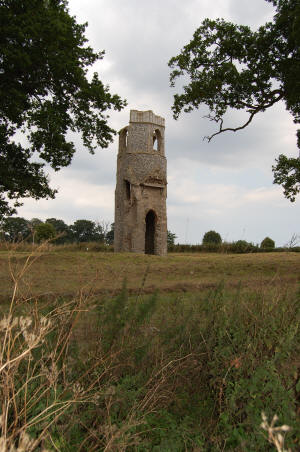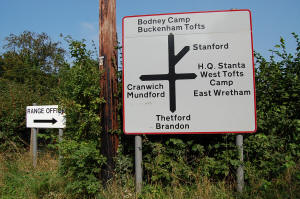|
|
|
|
Causes of Desertion in Norfolk
|
Here are some of the main causes of desertion in the
county:
|
1) Climate Change/Crop FailureThe 13th Century
was a period of stable weather - with predominantly warm
and dry conditions but by the 14th Century the
climate had become considerably colder and wetter.
Higher than average rainfall caused harvests to fail in
1315 and 1316 and problems continued in the period
between 1319 and 1321 when disease spread amongst
cattle. These years of poor harvests and widespread food
shortages undermined the stability of many rural
communities.
|
2) The Black Death
It is often assumed that the Black Death was the
cause of many deserted medieval villages. It occurred in 1349 at a time when the
population was already weakened by lack of food but,
with the possible exception of Little Ringstead, it did
not cause actual desertions in the county - but it did
have a profound effect upon the overall population of
14th century Norfolk. It is estimated that the Black
Death killed between 30-60% of people. This would have
led to the abandonment of homes and farmsteads and the
fracturing and fragmenting of rural communities.
In some cases, reductions in taxation were applied to
villages that had lost residents due to the Black Death
and these help to paint a picture of the effects of the
plague.
Abandoned land may have been acquired by Lords of the
manor which may have contributed to the increase in
enclosures for sheep (see below).
|
3) Farming Practices (Flockmasters)
During the medieval period most villages operated an
'open field' system where peasants would farm strips of
land. After the hard winters of the 14th century and the
decline in the population caused by the Black Death,
richer farmers bought up land and used it for grazing
sheep. At Gayton, Bawsey, Leziate, Mintlyn and
Ashwicken, Thomas Thursby (who was the lord of the
manor) enclosed commons and waste land to create pasture
for his flocks.
The action of flockmasters was almost certainly to
blame for the abandonment of Thorpland and Alethorpe
near Fakenham. At Thorpland an unscrupulous landlord
named Henry Fermor, who in 1521 owned more than 15,000
sheep, was accused of enclosing common land, destroying
houses and buying up land for pasture. At Alethorpe, a
certain William Dye was engaged in similar activities
and was also accused of driving his sheep across
villagers' crops and of being threatening and menacing
towards them.
A similar complaint was brought against Edmund Jermyn
at Sturston in the brecklands when he tried to take the
glebe land which consisted of 400 acres of arable.
The enclosure of land
was one of the main causes leading to Robert Kett's
rebellion in 1549.
|
|
4) Stately Homes or Emparking
|
|
|
|
........the man of wealth and pride
Takes up a space that many poor supplied;
Space for his lake, his park's extended bounds,
Space for his horse, equipage and hounds.
The robe that wraps his limbs in silken sloth
Has robbed the neighbouring fields of half their
growth. |
|
Some deserted villages occurred as a result of the
building of stately homes. Many stately homes were built
in Norfolk during the 18th
Century and some villages were cleared to make way for
parkland or to improve the view from the hall's windows.
To be fair, some of these villages may have been in
decline before the halls were built.
Houghton is a good example of a village that was lost
when Sir Robert Walpole created
Houghton Hall. A similar
fate befell Wolterton when his brother, Horatio Walpole,
commissioned Wolterton Hall.

Wolterton Church Tower
At Wolterton the old church tower remains just behind
the hall. The last burials in the churchyard coincided
with the building of the estate. Other villages affected
by emparking were Felbrigg,
Holkham, Didlington, Westwick,
Kilverstone, Haveringland, Bayfield, Narford, Hargham and Gunton.
5) Soil Quality
The Brecklands With over 30 identified locations - the
Brecklands has the highest
concentration of deserted villages in Norfolk. During
the prehistoric period the Brecklands were the most
densely populated region of England due to the light,
workable soil and the ease with which woodland could be
removed. The early farmers practised a slash and burn
technique and the 'broken' plots of land became known as
Brecks. However, once the trees were removed the
light soil had a tendency to blow away and dust storms
were a common feature of the area. When the diarist John Evelyn passed through the region in
1677 he remarked:
|
|
'The Travelling Sands.......that have so damaged the
country, rouling from place to place, like the Sands in
the Deserts of Lybia, quite overwhelmed some gentleman's
whole estates.' |
There is also a local joke which contains more than a
grain of truth: 'Which county is your farm in, Norfolk
or Suffolk?' 'Well, that depend on which way the
winds blowing.'Faced with such infertile soil it's
not surprising that many settlements were abandoned. The
introduction of sheep would have further exacerbated the
situation by removing vegetation. Rabbit warrens were
also a common feature of the area - as at Santon,
Stanford, Wangford and Sturston. Sturston became
deserted some time in the 16th century and today it lies
in the middle of the STANTA Battle Area. (It is a rare
example of a doubly deserted settlement.) Davison,
however, urges a note of caution in relation to the
'sandy soil theory' - pointing out that there's not
always a direct correlation between the soil quality and
the likelihood of desertion. Fakenham Area
The other main concentration of deserted settlements in
Norfolk lies around Fakenham. Here the soil is high in
clay - making it poorly drained and hard to work and
this was almost certainly a factor in the abandoment of
villages such as Godwick. Even today, it is quite common
to see the hollow ways at Godwick with standing water -
particularly after recent rain.
|
|
|
6) Coastal Erosion
Some villages have became deserted due to coastal
erosion. Just off the coast at Cromer is the submerged
village of Shipden which was washed away during the 14th
Century. In 1888 a tug struck the church tower of St.
Peter's Church.
Further down the coast lies the famous lost village
of Eccles-on-Sea. Much of the
village was washed away during a violent storm in 1604
and in 1895 the church tower slipped onto the beach -
where it remained until the sea finally reclaimed it.
Other lost villages of this stretch of coastline
include: Clare (near Mundesley), Keswick (near Bacton),
Wimpwell (near Happisburgh) and Waxham Parva (near
Horsey).
|
7) EngrossmentOccurred from the sixteenth
century onwards and was the result of the lord of the
manor gradually purchasing the land of his tenants -
usually after they died. Ultimately, this process would
culminate in the creation of an estate consisting of a
sole manor house, a home farm and a church. Examples of
engrossment in Norfolk include: West Raynham, Illington, Threxton
and Narford.
|
8) Stanford Military Training Area
Deserted villages have also occurred in more recent
history. During the Second World War an area in the
Brecklands was cleared in
order to create a military training area - now known as
STANTA or the Stanford Training Area. To create this
land for army manoeuvres, several villages were lost
including: Lynford, Langford, West Tofts, Tottington and
Stanford. Villagers in parts of Ickborough, Hilborough,
Little Cressingham, Merton, Thompson, Wretham and Stow
Bedon were also affected.

Stanford Battle
Training Area
Following a public meeting in June 1942 villagers
were given one month to move out by the military. In
total, nearly 1,000 men, women and children were
forcibly evacuated from the 17,500-acre site. It was
understood, at the time, that these people would be able
to move back to their homes after the war - however the
military never honoured this promise. Many of the
churches still remain and can be visited with special
permission from the Ministry of Defence. In fact, in
September 2009 one of the evacuees, a William Hancock,
was given special dispensation to be buried in the
churchyard of St Andrew's Church at Tottington next to
members of his family. Mr Hancock was the first person
to be buried at the church for 50 years; he had also
been christened here. |
9) Proximity to Norwich
Neil
Batcock (author of The Ruined Churches of Norfolk)
has suggested that the abandonment of Markshall on the
south side of Norwich may have been due to its closeness
to Norwich. A large city like Norwich may have sucked
population from surrounding marginal villages. A similar
fate may have befallen deserted villages such as
Bowthorpe, Earlham and Bixley. |
|
|
|

